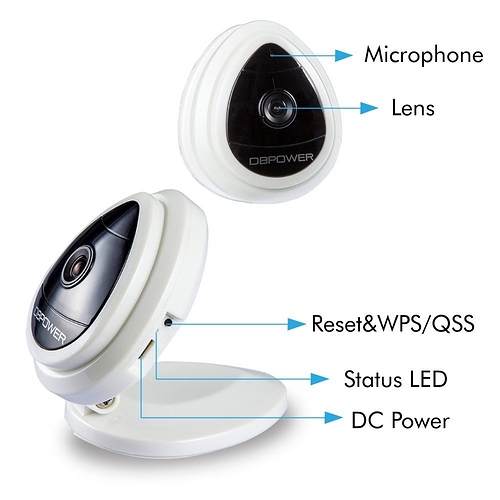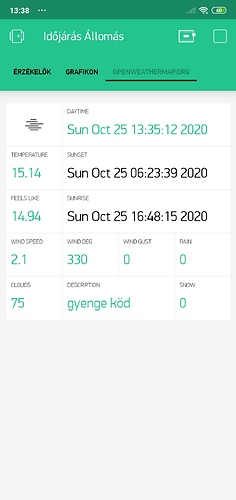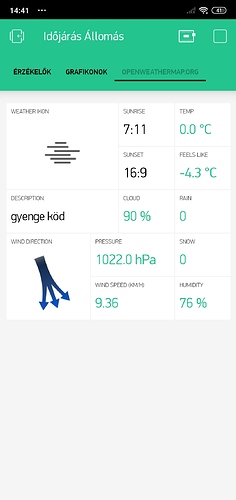I didn’t say then. I assume that by unplugging the wind speed meter connector, the error is also eliminated.
Yes, both, I cut/paste your example code . . . which worked perfectly, thnx!!!
Wind was an issue with my prototype, I had a thin, aluminium tube (an old TV antenna) that swayed quite badly. This is a solid stainless steel pole, even when I try to move the pole (which takes some effort) it it doesn’t cause an issue.
I’m thinking I need to experiment with low/high vs high/low interrupt; and/or narrow the window when it detects the transition . . .in a previous life I had access to no end of test equipment, an decent CRO or Network Analyser would be very handy right now . . .
Oh well, trial and error troubleshooting it is.
cul
billd
Hi Kastler, its the rain gauge, not the wind speed ;-)) and yeas the errors stop when disconnected.
I think its electrical noise on the 2m cable from the sensor to the interrupt pin.
cul
billd
Sorry. Try an external pull-up resistor.
i fixed some bugs i found …
//Thanks to Khoih
#include <Time.h>
#ifndef ESP32
#error This code is intended to run on the ESP32 platform! Please check your Tools->Board setting.
#endif
#define BLYNK_PRINT Serial
#define USE_BLYNK_WM false
#define USE_SSL false
#define USE_LOCAL_SERVER false
#if USE_SSL
#include <WiFiClientSecure.h>
#else
#include <WiFiClient.h>
#endif
#if USE_BLYNK_WM
// Not use #define USE_SPIFFS => using EEPROM for configuration data in WiFiManager
// #define USE_SPIFFS false => using EEPROM for configuration data in WiFiManager
// #define USE_SPIFFS true => using SPIFFS for configuration data in WiFiManager
// Be sure to define USE_SPIFFS before #include <BlynkSimpleEsp8266_WM.h>
//#define USE_SPIFFS true
#define USE_SPIFFS false
#if (!USE_SPIFFS)
// EEPROM_SIZE must be <= 4096 and >= CONFIG_DATA_SIZE (currently 172 bytes)
#define EEPROM_SIZE (4 * 1024)
// EEPROM_START + CONFIG_DATA_SIZE must be <= EEPROM_SIZE
#define EEPROM_START 2048
#endif
// Force some params in Blynk, only valid for library version 1.0.1 and later
#define TIMEOUT_RECONNECT_WIFI 10000L
#define RESET_IF_CONFIG_TIMEOUT true
#define CONFIG_TIMEOUT_RETRYTIMES_BEFORE_RESET 5
// Those above #define's must be placed before #include <BlynkSimpleEsp8266_WM.h>
#if USE_SSL
#include <BlynkSimpleEsp32_SSL_WM.h> // https://github.com/khoih-prog/Blynk_WM
#else
#include <BlynkSimpleEsp32_WM.h> // https://github.com/khoih-prog/Blynk_WM
#endif
#else
#if USE_SSL
#include <BlynkSimpleEsp32_SSL.h>
#define BLYNK_SERVER_HARDWARE_PORT 9443 // blynk server SSL port
#else
#include <BlynkSimpleEsp32.h>
#define BLYNK_SERVER_HARDWARE_PORT 8080 // blynk server port
#endif
char ssid[] = ""; // wifi SSID
char pass[] = ""; // wifi password
#if USE_LOCAL_SERVER
char auth[] = ""; // Local Blynk server token
char server[] = "accout.duckdns.org"; // blynk server
#else
char auth[] = ""; //Cloud Blynk server token
char server[] = "blynk-cloud.com"; // Cloud Blynk server
#endif
#endif
#define DEBUG_ON
#include <SPI.h>
#include <NTPClient.h>
#include <WidgetRTC.h>
#include <TimeLib.h>
#include <WiFi.h>
#include <ESPmDNS.h>
#include <WiFiUdp.h>
WiFiUDP udp;
#include <ArduinoOTA.h>
#include <BME280I2C.h> //https://github.com/finitespace/BME280/tree/master/src
#include <Wire.h>
#include <NTPtimeESP.h>
BME280I2C bme;
#define uS_TO_S_FACTOR 1000000
#define TIME_TO_SLEEP 600 //set deep sleep time (in seconds)
#define COUNT_PERIOD 60000 // measure interval (ms)
#define DEBOUNCE_TIME 90
#define RADIUS (0.09f) // in meter
#define DIAMETER (2 * RADIUS)
#define RAIN_AMOUNT (0.438f) // Precipitation
#define VOLT_DETECTION_PIN 34 // voltage detection pin number
#define RAIN_GAUGE_PIN 14 // Rain pin number
#define WIND_SPEED_PIN 35 // wind speed pin number
#define UV_INDEX_PIN 36 // UV Index detection pin number
#define WIND_DIRECTION_PIN 39 // Wind direction pin number
#define BLYNK_VPIN_WIND_DIRECTION V1
#define BLYNK_VPIN_TEMP V2
#define BLYNK_VPIN_WIND_SPEED V3
#define BLYNK_VPIN_HUMID V4
#define BLYNK_VPIN_RAIN_AMOUNT V5
#define BLYNK_VPIN_PRESSURE V6
#define BLYNK_VPIN_HALL_SENSOR V7
#define BLYNK_VPIN_WIND_SPEED_MAX V8
#define BLYNK_VPIN_NTP_TIME V9
#define BLYNK_VPIN_CPU_TEMP2 V10
#define BLYNK_VPIN_BATT_VOLT V11
#define BLYNK_VPIN_UV_INDEX V12
#define BLYNK_VPIN_NTP_DATE V13
#define BLYNK_VPIN_DEW_POINT2 V14
#define BLYNK_VPIN_RSSI1 V15
#define BLYNK_VPIN_NTPLED V16
#define BLYNK_VPIN_LAST_DAY_RAIN V17
#define BLYNK_VPIN_UV_MAX V18
int Wdir = 0;
int measurement = 0;
unsigned int RPM = 0; // Revolutions per minute
float windSpeedMetrePerSec = 0; // Wind speed (m/s)
float windSpeedKmPerHr = 0; // Wind speed (km/h)
float voltage = (((float)analogRead(VOLT_DETECTION_PIN) * (3.3 / 4095)) * 2) + 0.24; // battery voltage
float UVIndex = ((((float)analogRead(UV_INDEX_PIN) * (3.3 / 4095)) - 0.99)*8.333); // UV Index ML8511
float windDirection = ((float)analogRead(WIND_DIRECTION_PIN)); // Wind direction
volatile unsigned int counter = 0; // magnet counter for sensor
volatile unsigned int currentCount;
volatile float totalAmount = 30;
volatile float lastRainAmount = 0;
volatile int lastday;
volatile int startday = 0;
volatile float UVMax = 0;
volatile float windMax_kmh;
volatile int windDirAverage;
volatile float windDirCount;
volatile int windDirCalcNum;
volatile long startTime;
volatile long RainstartTime;
volatile bool windDataReady = false;
volatile int last_windspeed_interrupt = 0;
volatile int currMillis;
static long RainlastMillis = millis();
static long RaincurrMillis;
String currentTime;
String currentDate;
const String MyDayOfWeek[7] = {"Vasárnap", "Hétfő", "Kedd", "Szerda", "Csütörtök", "Péntek", "Szombat"};
String printDigits(int digits)
{
String new_digits = ":";
if (digits < 10) {
new_digits += "0";
}
new_digits += String(digits);
return new_digits;
}
#ifdef __cplusplus
extern "C" {
#endif
uint8_t temprature_sens_read();
#ifdef __cplusplus
}
#endif
uint8_t temprature_sens_read();
BlynkTimer timer;
WidgetRTC rtc;
WidgetLED ledntp(BLYNK_VPIN_NTPLED);
NTPClient timeClient(udp, "europe.pool.ntp.org", 3600, 60000);
NTPtime NTPch("ch.pool.ntp.org"); // Choose server pool as required
/*
* The structure contains following fields:
* struct strDateTime
{
byte hour;
byte minute;
byte second;
int year;
byte month;
byte day;
byte dayofWeek;
boolean valid;
};
*/
strDateTime dateTime;
BLYNK_CONNECTED()
{
rtc.begin();
Blynk.syncAll();
}
void IRAM_ATTR RainSensor();
void IRAM_ATTR WindSpeedSensor();
void setup()
{
// Debug console
pinMode(RAIN_GAUGE_PIN, INPUT);
pinMode(WIND_SPEED_PIN, INPUT);
pinMode(WIND_DIRECTION_PIN, INPUT);
pinMode(UV_INDEX_PIN, INPUT);
pinMode(VOLT_DETECTION_PIN, INPUT);
float windDirection = ((float)analogRead(WIND_DIRECTION_PIN));
Serial.begin(115200);
#if USE_BLYNK_WM
Blynk.begin("ESP32-Weather-Station");
#else
WiFi.mode(WIFI_STA);
Blynk.connectWiFi(ssid, pass);
Blynk.config(auth, server, BLYNK_SERVER_HARDWARE_PORT);
Blynk.connect();
#endif
ArduinoOTA.setHostname("Weather-Station");
ArduinoOTA.begin();
Blynk.setProperty(BLYNK_VPIN_WIND_DIRECTION, "rotation", Wdir);
Wire.begin();
while (!bme.begin()) //start BME 280
{
Serial.println("Could not find BMP280 sensor!");
delay(1000);
}
switch (bme.chipModel())
{
case BME280::ChipModel_BME280:
Serial.println("Found BMP280 sensor! Success.");
break;
case BME280::ChipModel_BMP280:
Serial.println("Found BMP280 sensor! No Humidity available.");
break;
default:
Serial.println("Found UNKNOWN sensor! Error!");
}
timer.setInterval(500L, measureAll);
timer.setInterval(50000L, CalibrateTimeWithNTP);
timer.setInterval(300000L, sendSensor);
attachInterrupt(digitalPinToInterrupt(WIND_SPEED_PIN), WindSpeedSensor, RISING);
attachInterrupt(digitalPinToInterrupt(RAIN_GAUGE_PIN), RainSensor, RISING);
// start timing
startTime = millis();
}
void loop()
{
Blynk.run(); //start the Blynk sketch
timer.run(); //start the timer
ArduinoOTA.handle();
}
void measureAll()
{
WindDir();
if (millis() >= startTime + COUNT_PERIOD )
{
windDirCalcNum = 0;
windDirCount = 0;
startTime = millis();
currentCount = counter;
counter = 0;
windDataReady = true;
}
WindVelocity();
}
void sendSensor()
{
static float temp(NAN), hum(NAN), pres(NAN);
static float voltage; // battery voltage
static float UVIndex; // UV Index
static float windDirection; // Szélirány
static double gamma; // calculate dewpoint
static double dp; // calculate dewpoint
static long rssi; // read signal strength
measurement = hallRead();
BME280::TempUnit tempUnit(BME280::TempUnit_Celsius); // read BME 280
BME280::PresUnit presUnit(BME280::PresUnit_hPa); // read BME 280
bme.read(pres, temp, hum, tempUnit, presUnit); // read BME 280
voltage = (((float)analogRead(VOLT_DETECTION_PIN) * (3.3 / 4095)) * 2) + 0.24; // battery voltage
UVIndex = ((((float)analogRead(UV_INDEX_PIN) * (3.3 / 4095)) - 0.99)*8.333); // UV Index ML8511
if (UVIndex < 0)
{
UVIndex = 0;
}
if (UVIndex > UVMax)
{
UVMax = UVIndex;
}
windDirection = ((float)analogRead(WIND_DIRECTION_PIN)); // Szélirány
gamma = log(hum / 100) + ((17.62 * temp) / (243.5 + temp)); // calculate dewpoint
dp = 243 * gamma / (17.62 - gamma); // calculate dewpoint
rssi = WiFi.RSSI();
Blynk.setProperty(BLYNK_VPIN_WIND_DIRECTION, "rotation", windDirAverage); // image rotating to wind direction
Blynk.virtualWrite(BLYNK_VPIN_WIND_DIRECTION, 1);
Blynk.virtualWrite(BLYNK_VPIN_TEMP, temp); //temperature
Blynk.virtualWrite(BLYNK_VPIN_WIND_SPEED, windSpeedKmPerHr); //Wind speed
Blynk.virtualWrite(BLYNK_VPIN_WIND_SPEED_MAX, windMax_kmh); //Wind speed max
Blynk.virtualWrite(BLYNK_VPIN_HUMID, hum); //humidity
Blynk.virtualWrite(BLYNK_VPIN_LAST_DAY_RAIN, lastRainAmount); // Yesterday's Rainfall
Blynk.virtualWrite(BLYNK_VPIN_RAIN_AMOUNT, totalAmount); // Today's Rainfall
Blynk.virtualWrite(BLYNK_VPIN_PRESSURE, pres); //pressure
Blynk.virtualWrite(BLYNK_VPIN_HALL_SENSOR, measurement); //hallsensor
Blynk.virtualWrite(BLYNK_VPIN_CPU_TEMP2, (temprature_sens_read() - 32) / 1.8); //CPU Temp
Blynk.virtualWrite(BLYNK_VPIN_BATT_VOLT, voltage); //Battery Voltage
Blynk.virtualWrite(BLYNK_VPIN_UV_INDEX, UVIndex); //UV index
Blynk.virtualWrite(BLYNK_VPIN_DEW_POINT2, dp); //Dew point
Blynk.virtualWrite(BLYNK_VPIN_RSSI1, rssi); //rssi
Blynk.virtualWrite(BLYNK_VPIN_UV_MAX, UVMax); //UVMax today
Blynk.virtualWrite(BLYNK_VPIN_NTP_TIME, currentTime); //Time
Blynk.virtualWrite(BLYNK_VPIN_NTP_DATE, currentDate); //Date
}
void WindDir()
{
float windDirection = ((float)analogRead(WIND_DIRECTION_PIN));
if (windDirection < 190)
Wdir = 270; // W
else if (windDirection < 420)
Wdir = 315; // NW
else if (windDirection < 700)
Wdir = 292.5; // W-NW
else if (windDirection < 900)
Wdir = 0; // N
else if (windDirection < 1300)
Wdir = 337.5; // N-NW
else if (windDirection < 1500)
Wdir = 225; // SW
else if (windDirection < 1600)
Wdir = 247.5; // W-SW
else if (windDirection < 2250)
Wdir = 45; // NE
else if (windDirection < 2400)
Wdir = 22.5; // N-NE
else if (windDirection < 2900)
Wdir = 180; // S
else if (windDirection < 3100)
Wdir = 202.5; // S-SW
else if (windDirection < 3400)
Wdir = 135; // SE
else if (windDirection < 3600)
Wdir = 157.5; // S-SE
else if (windDirection < 3840)
Wdir = 90; // E
else if (windDirection < 3950)
Wdir = 67, 5; // E-NE
else if (windDirection < 4095)
Wdir = 112.5; // E-SE
else
Wdir = 0; // N
windDirCalcNum++;
windDirCount += Wdir;
windDirAverage = windDirCount / windDirCalcNum;
//Blynk.virtualWrite(V20, windDirAverage);
}
void IRAM_ATTR RainSensor()
{
RaincurrMillis = millis();
if (millis() >= RainlastMillis + DEBOUNCE_TIME)
{
totalAmount += RAIN_AMOUNT;
RainlastMillis = millis();
}
}
void WindVelocity()
{
if (windDataReady)
{
noInterrupts();
windDataReady = false;
RPM = (( currentCount * (60000 / COUNT_PERIOD ))/2);
windSpeedMetrePerSec = (RPM * DIAMETER * PI) / 60;
windSpeedKmPerHr = windSpeedMetrePerSec * 3.6; // Calculate wind speed on km/h
if (windSpeedKmPerHr >= windMax_kmh)
{
windMax_kmh = windSpeedKmPerHr;
}
Blynk.setProperty(BLYNK_VPIN_WIND_DIRECTION, "rotation", windDirAverage); // image rotating to wind direction
Blynk.virtualWrite(BLYNK_VPIN_WIND_DIRECTION, 1); // image number
Blynk.virtualWrite(BLYNK_VPIN_WIND_SPEED, windSpeedKmPerHr); // Wind speed sending
Blynk.virtualWrite(BLYNK_VPIN_WIND_SPEED_MAX, windMax_kmh); // Wind speed max
Blynk.virtualWrite(BLYNK_VPIN_RAIN_AMOUNT, totalAmount); // Today's Rainfall
interrupts();
}
}
void IRAM_ATTR WindSpeedSensor()
{
if ( micros() - last_windspeed_interrupt >= 250 )
{
counter++;
last_windspeed_interrupt = micros();
}
}
void CalibrateTimeWithNTP()
{
// first parameter: Time zone in floating point (for India); second parameter: 1 for European summer time; 2 for US daylight saving time; 0 for no DST adjustment; (contributed by viewwer, not tested by me)
dateTime = NTPch.getNTPtime(1.0, 1);
// check dateTime.valid before using the returned time
// Use "setSendInterval" or "setRecvTimeout" if required
if(dateTime.valid){
NTPch.printDateTime(dateTime);
byte actualHour = dateTime.hour;
byte actualMinute = dateTime.minute;
byte actualsecond = dateTime.second;
int actualyear = dateTime.year;
byte actualMonth = dateTime.month;
byte actualday = dateTime.day;
byte actualdayofWeek = dateTime.dayofWeek;
String currentTime = String(dateTime.hour) + printDigits(dateTime.minute);
String currentDate = String(dateTime.year) + "." + dateTime.month + "." + dateTime.day + " " + MyDayOfWeek[(dateTime.dayofWeek)-1];
if ( lastday != dateTime.day )
{
startday = 1;
lastday = dateTime.day;
}
if (startday == 1)
{
startday = 0;
lastRainAmount = totalAmount;
totalAmount = 0;
windMax_kmh = 0;
UVMax = 0;
ledntp.on();
}else{
ledntp.off();
}
Blynk.virtualWrite(BLYNK_VPIN_NTP_TIME, currentTime); //Time
Blynk.virtualWrite(BLYNK_VPIN_NTP_DATE, currentDate); //Date
}
}
Looks very interesting. I want to do something similar. Do you have manual or something?
The circuit diagram and the PCB plans (made in EAGLE) are unfortunately on my laptop that I can’t turn on. But the files needed to build after that are basically here in these topics.
Hi,
Just a question: Why are you using a 100mH coil on the DC output?
100uH was designed for dc converter noise filtering, but not included in the final version.
I inserted the image of such a tiny wifi camera into the blynk as a weather image. For the time being, only on a temporary basis.
UPDATE: Confirmed the noise on the cable . . . it runs very close to 240V light cable in my garage . . . triggered by PIR sensor . . . everytime the light switches on/off there is a random spike in rain value. I’ve tested this by adjusting the sensor time to a few seconds, then deliberating triggering it, this causes a corresponding increase in rainfall . . .
I’ve moved the sensor cables as far away from the power cable, it has helped but still getting RFI . . . I have ordered a shield for the cable . . . ZUJ . . .
cul
billd
Greetings Blynk specialists, tell me how to install beautiful widgets like in your weather station project ??
Приветствую специалистов Blynk , подскажите как установить красивые виджеты как в вашем проекте метеостанции??






